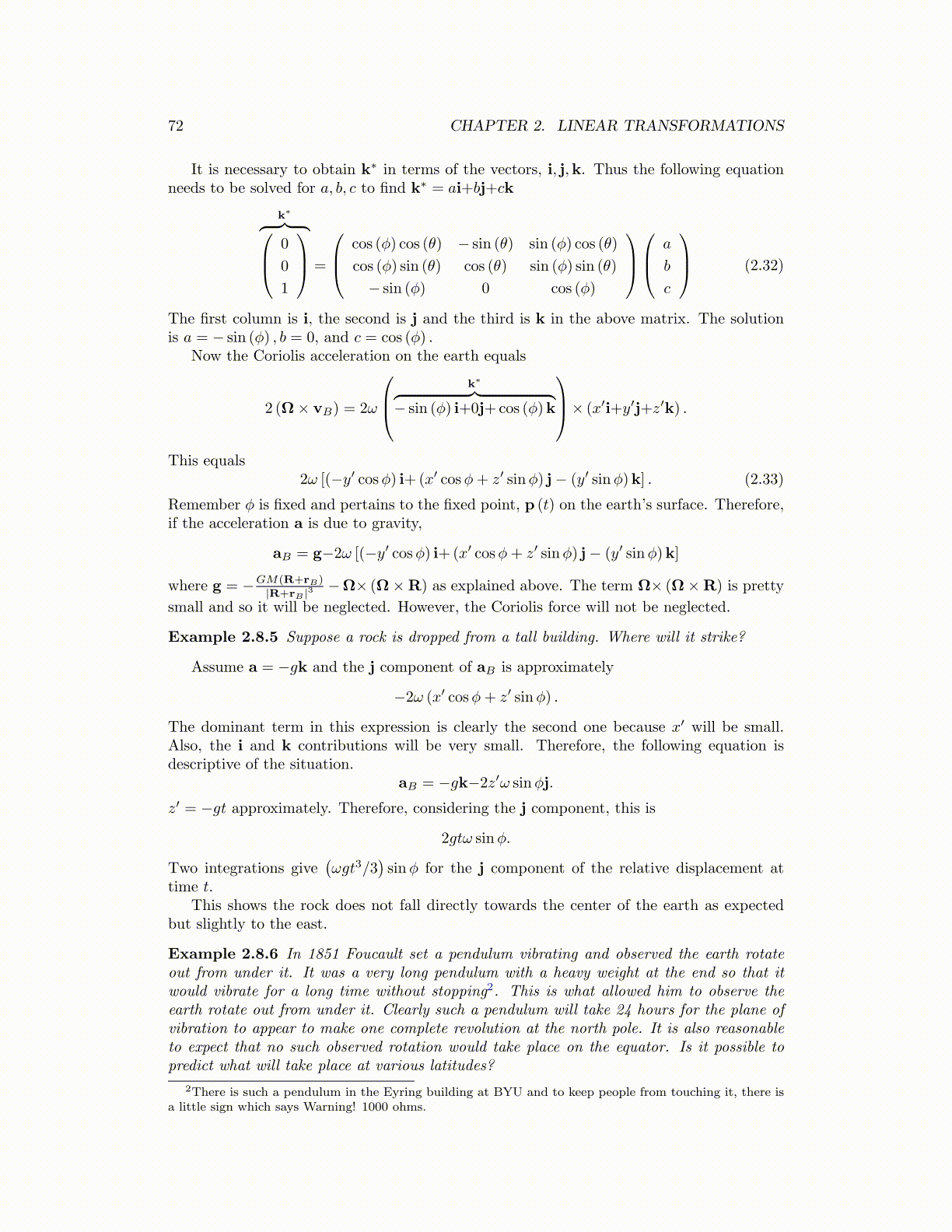
72 CHAPTER 2. LINEAR TRANSFORMATIONS
It is necessary to obtain k∗ in terms of the vectors, i, j,k. Thus the following equationneeds to be solved for a, b, c to find k∗ = ai+bj+ck
k∗︷ ︸︸ ︷ 0
0
1
=
cos (ϕ) cos (θ) − sin (θ) sin (ϕ) cos (θ)
cos (ϕ) sin (θ) cos (θ) sin (ϕ) sin (θ)
− sin (ϕ) 0 cos (ϕ)
a
b
c
(2.32)
The first column is i, the second is j and the third is k in the above matrix. The solutionis a = − sin (ϕ) , b = 0, and c = cos (ϕ) .
Now the Coriolis acceleration on the earth equals
2 (Ω× vB) = 2ω
k∗︷ ︸︸ ︷− sin (ϕ) i+0j+cos (ϕ)k
× (x′i+y′j+z′k) .
This equals2ω [(−y′ cosϕ) i+(x′ cosϕ+ z′ sinϕ) j− (y′ sinϕ)k] . (2.33)
Remember ϕ is fixed and pertains to the fixed point, p (t) on the earth’s surface. Therefore,if the acceleration a is due to gravity,
aB = g−2ω [(−y′ cosϕ) i+(x′ cosϕ+ z′ sinϕ) j− (y′ sinϕ)k]
where g = −GM(R+rB)
|R+rB |3 −Ω× (Ω×R) as explained above. The term Ω× (Ω×R) is pretty
small and so it will be neglected. However, the Coriolis force will not be neglected.
Example 2.8.5 Suppose a rock is dropped from a tall building. Where will it strike?
Assume a = −gk and the j component of aB is approximately
−2ω (x′ cosϕ+ z′ sinϕ) .
The dominant term in this expression is clearly the second one because x′ will be small.Also, the i and k contributions will be very small. Therefore, the following equation isdescriptive of the situation.
aB = −gk−2z′ω sinϕj.
z′ = −gt approximately. Therefore, considering the j component, this is
2gtω sinϕ.
Two integrations give(ωgt3/3
)sinϕ for the j component of the relative displacement at
time t.This shows the rock does not fall directly towards the center of the earth as expected
but slightly to the east.
Example 2.8.6 In 1851 Foucault set a pendulum vibrating and observed the earth rotateout from under it. It was a very long pendulum with a heavy weight at the end so that itwould vibrate for a long time without stopping2. This is what allowed him to observe theearth rotate out from under it. Clearly such a pendulum will take 24 hours for the plane ofvibration to appear to make one complete revolution at the north pole. It is also reasonableto expect that no such observed rotation would take place on the equator. Is it possible topredict what will take place at various latitudes?
2There is such a pendulum in the Eyring building at BYU and to keep people from touching it, there isa little sign which says Warning! 1000 ohms.